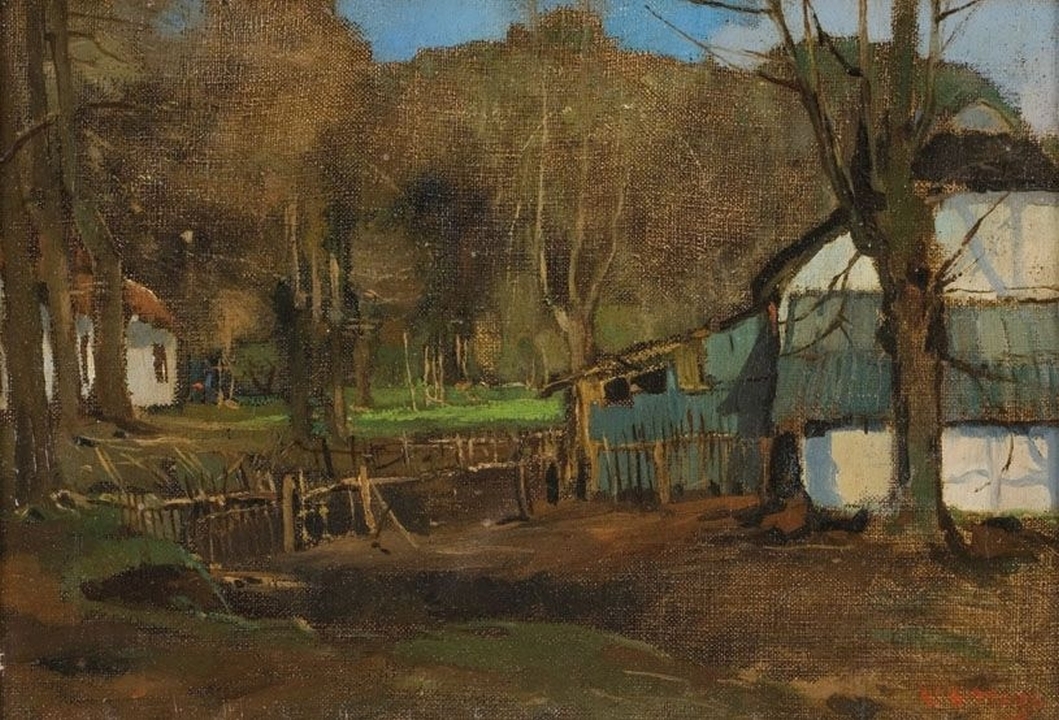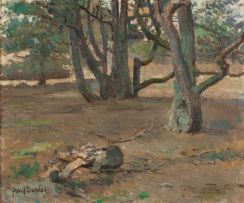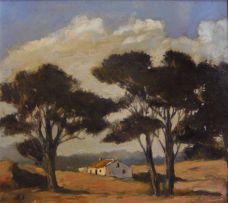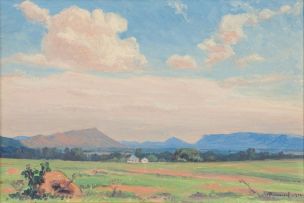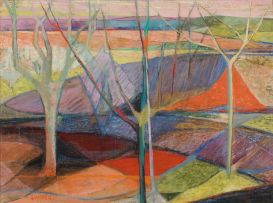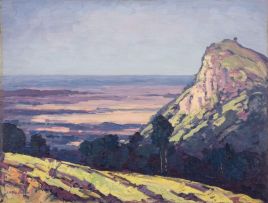Important South African Art
Live Auction, 16 May 2011
Session Two
Incl. Buyer's Premium & VAT
About this Item
signed; signed and inscribed with the title on the stretcher on the reverse
Notes
Painted on the 25th July 1916
The paintings of Pieter Wenning, a grossly underrated artist in the opinion of Stephan Welz, are exciting much interest amongst art collectors with At Claremont, CP having sold for R1 782 400 at Strauss & Co's March 2011 sale in Cape Town, establishing a new record for the artist.
Landscape Bishop's Court was painted when Wenning was in Cape Town from June until August 1916 and working productively. D. C. Boonzaier, journalist and cartoonist for De Burger and Wenning's mentor and greatest supporter, observes in his diary entry:
Nou volg vir Wenning 'n vrugbare week. Op 25 Julie maak hy in Bishopscourt 'n klein skilderytjie "in brown, green and white; a few old houses, with the dense forest in the background" (nr 11 in lys op bl. 31-32 - Pl. 34).i
Because Wenning had to return to Pretoria for Van Schaik's wedding, an impromptu exhibition was held in Boonzaier's office in the Burger building in Keerom Street to enable sponsors to view and select work and other interested parties to purchase paintings. Boonzaier comments:
Miss Nita Spilhaus, Miss Ruth Prowse and Miss Woods (of the Argus) call together to see the work. They are full of enthusiasm and Miss Spilhaus says Wenning must throw up his present work and take up painting as a profession. They all select the large Bishop's Court as one of the best things in the collection.ii
In the list of works sold, Boonzaier notes this painting as Ou Huisie teen Agtergrond van Digte Bome, Bishopscourt, states that it was painted on 25 July and purchased by F. K. Kendall for £4-4-0.iii Francis Kaye Kendall was an architect in the celebrated firm, Herbert Baker Kendall and Morris. Kendall, with his educated eye and refined sensibility, was clearly drawn to this image of vernacular Cape architecture. The light paint treatment of the trees contrasts with the thickly painted walls grounding the buildings in this sylvan scene. The fencing, painted with rapid strokes that lend an elegant rhythm to the composition, accentuate Wenning's mastery of brushwork learnt from the Japanese painters he so admired.
Boonzaier's diary entry of 27 May 1918 contains his response to Wolke Pretoria:
Another oil, considerably smaller in size, represents Pretoria - or, may be, one of its suburbs, during the progress of a heavy thunderstorm. It is a charming study in greys and subdued greens. The sky covers more than half the canvas, the landscape being shown in a narrow strip at the bottom. The whole thing is conceived in Wenning's happiest vein and I am almost inclined to prefer it to the larger picture. ... I wrote immediately to W. telling him what satisfaction the pictures - especially the first two - had given me, and in the evening took them to the Michaelis Café where they were greatly admired by Wray, Peers, Ruth Prowse, Magda Sauer and others.iv
It is small wonder that this painting elicited so many favourable responses. Wenning's ability to capture a sense of place with what are essentially a few abstracted brushstrokes and articulated lines is very evident. His mastery in marrying Dutch Impressionsim that favoured deeper colours and subtle light with local environmental conditions to evolve a style that has sometimes been referred to as Cape Impressionism, was to have a marked influence on several artists including his friend, Nita Spilhaus and on Gregoire Boonzaier, the son of his mentor.
i Ibid, page 31.
ii J. Du P. Scholtz, D. C. Boonzaier en Pieter Wenning: Verslag van 'n Vriendskap, Tafelberg, 1973, page 31.
iii Ibid, page 32.
iv Ibid, page 55.
Provenance
Max Sachar
Literature
J. du P Scholtz, DC Boonzaier en Pieter Wenning. Verslag van 'n Vriendskap, Cape Town, 1973, page 31 and illustrated page 103, plate 34.
